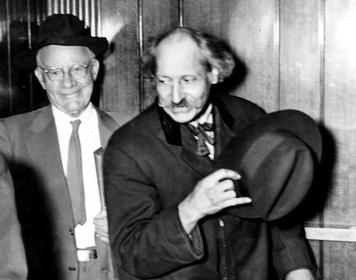Since the 1970s, a radio station formally named UVB-76 has been transmitting strange sounds at a frequency of 4625kHz. The exact date of the first transmission is up for contention, as is everything else about the radio station.
The strange sounds have made way for bizarre and somewhat impossible conspiracy theories. The radio may have taken on new call signs in the years since its first transmission, but the nature of the messages remains the same.
To dig into UVB-76, also known as MDZHB, we must first explore its origin. Researchers have dedicated years to uncovering the exact location of this bizarre radio station.
It turns out there were not one but two transmitters. The first is believed to be in a remote area of St. Petersburg, surrounded by abandoned buildings and power lines. This is the one believed to still be active.
The second lies within an abandoned mini-military town, Povarovo, in the Moscow Oblast of Russia. From first-hand reports, the radio station has since been abandoned, and access is completely restricted to the abandoned building where the antenna sits.


Some reports indicate that one of the sites used to transmit UVB-76 has since been abandoned. The radio station transmits a dull buzzing tone for 24 hours a day, 7 days a week, interrupted every few seconds with a horn.
Research indicates that the frequency 4625kHz belongs to the Russian military, but the monotonous tones are likely a ‘marker’ so that it cannot be used by anybody else.
If this radio station just transmits buzzes and horns, why is it so popular? In the 1990s, the radio station changed from transmitting beeps to only transmitting buzzes.
These buzzes are between 21 and 34 a minute, leading some to believe this is part of the secret code or message the station is trying to transmit.
Once every few weeks, the monotonous silence is broken by a male and female voice reading out a list of names and objects. The frequency of the buzzes would also sometimes change, making for even more bizarre listening.
Owner Of A Lonely Station
The radio would also broadcast the Russian phonetic alphabet in a format known as ‘monolyth’ messages to the Russian military.
Monlyth or Monolit messages follow a specific pattern: A call sign, a 5-digit number, a code word, a 4-digit number and two 4-digit number groups.
Another format the radio station uses is Uzor, which follows a similar format. Call sign, codeword, 4 digit number, code word and a 4 digit number.
These messages are highly encoded, and only specific recipients would be able to unscramble what the radio station is trying to convey. Some have theorised that this radio station transmits these messages to Russian spies living in foreign lands.
Another theory is that this radio station runs 24/7 so Russia can be ready for an invasion or other acts of war and transmit messages quickly and discreetly. The Russian government has been confronted about this bizarre station, but nobody has ever come forward to claim it.
Neither the Russian government nor the military say they have any knowledge or involvement with its transmission, although many believe this to be a lie.
Throughout the Cold War and Soviet era, number stations were incredibly popular and were used to transmit messages to spies.
What’s to say that UVB-76 is not another number station hidden in plain sight or perhaps a leftover relic of an era gone by that nobody has bothered to dismantle?

The latter theory makes the most sense, but in June 2010, something happened that confirmed that UVB-76 is very much still active.
A New King
On June 5th, 2010, listeners of the radio station were shocked when the transmission seemingly went off the air. The buzzing ceased, and the names stopped, but nobody knew why.
Internet investigators were at a loss; there was nobody they could contact to ask why, and all they could do was wait. Thankfully, they didn’t have to wait long, and on June 6th, 2010, UVB-76 began transmitting the dull buzzes again.
Some swore they heard morsels of morse code between these buzzes, but nobody could be sure. According to Wired, the radio transmissions continued as usual until August 2010, when they ceased again.
Investigators were becoming exceedingly suspicious, and their suspicions were further aroused on August 25th 2010, when the radio station began transmitting what sounded like faint knocking sounds.
After a period of silence, interrupted by the sound of shuffling feet, the song ‘Dance of the Swans’ by Russian composer Pyotr Tchaikovsky played momentarily over the stiff air.
Following this bizarre interruption, the station returned to normal, broadcasting buzzes, names, objects and places as if nothing had happened. Throughout these bizarre events, nobody ever directly addressed the audience or even spoke.
On September 7th 2010, the radio station changed its call sign. According to listeners, a male voice appeared, as it had many times before, reading the name ‘Mikhail Dmitri Zhenya Boris’.
Until this point, the station had been known as UVB-76, but now, it would take on the name MDZhB. Per standard protocol, the station followed up this call sign with a message. “04 979 DRENDOUT [numbers] TRENERSKIY.”
Internet Fame
By 2010, MDZhB was beginning to draw internet popularity, with more and more listeners tuning into the otherwise inconspicuous frequency.
The pattern of buzzes, numbers and codes continued like clockwork, and internet users desperately scrambled to decode them.
The next update in MDZhB’s history wouldn’t come until October 2015, when it began transmitting at the additional frequency of 6998kHz.
Over the next 5 years, MDZhB would change its name 3 times to ZhUOZ, ANVF and finally NZhTI in December 2020. The radio station would find further attention in January 2022 when it was seemingly hijacked by radio pirates.
These pirates used the now infamous radio station to play Gangnam Style and also transmitted audios that drew out famous memes when placed through a spectrum analyser.
Users on Twitter posted pictures of these decryptions, showing the ‘Troll Face’ meme and the V for Vendetta mask. Other pictures transmitted were of a wolf and of the radioactive symbol.

These broadcasts came just one month before Russia invaded Ukraine, sparking an intense war that is still raging. Many have called these broadcasts into question. Were they a warning of what was to come, or was this merely an eerie coincidence?
As of 2024, the radio station continues broadcasting the same buzzes and coded messages since its discovery in the 1970s/80s.
UVB-76 or MDZhB has gained a cult following and many have dedicated large portions of their time to listening and analysing every call signal and message.
Unfortunately, we still do not know who owns UVB-76 or why it exists. If the Russian government is involved, they are certainly keeping a tight lid on whatever is going on, and it’s clear the mystery will not be solved any time soon.
Sources
https://www.wired.com/2011/09/ff-uvb76/
https://www.abandonedspaces.com/public/ghost-radio-station.html
https://hackaday.com/2017/08/12/radio-mdzhb/
https://www.bbc.com/future/article/20170801-the-ghostly-radio-station-that-no-one-claims-to-run












Leave a comment